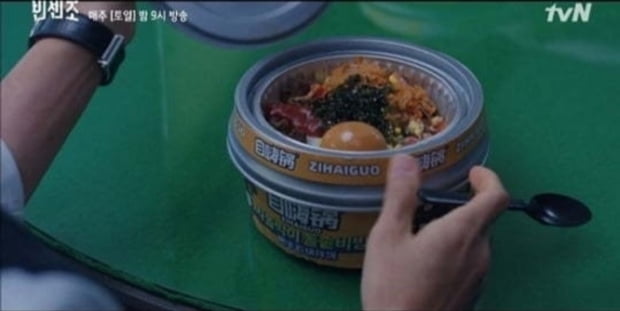
Marbled bibimbap launched by a Chinese company in the Vincenzo drama. Photo = tvN capture
“‘Dolpot Bibimbap’ is a rice dish unique to Heilongjiang, Jilin, and Liaoning provinces in northeastern China, including the Korean Peninsula.”
This is the explanation that came out when I searched for’Dolpot Bibimbap’ in the Baidu Encyclopedia, China’s largest portal site on the 3rd. The origin regions of stone-cooked bibimbap are listed in the order of ‘3 provinces in the northeast (China), North Korea, and South Korea’. It is a situation where people who do not know can be mistaken for food that originated in China and spread to Korea. The encyclopedia, operated by China’s leading portal, is raising debate on the origin of Korean-Chinese food again.

If you look at the photos that appear along with the search results of Dolsot Bibimbap, you can find an egg fried among various herbs such as bracken sprouts, spinach sprouts, zucchini stir-fry, mushroom stir-fry, carrot stir-fry, etc. It looks just like the stone-cooked bibimbap that has been eaten in Korea for a long time.
Korean Dolsot Bibimbap is a three-star food in Northeast China?
Controversy is expected as China, which has recently caused controversy over the origin of kimchi and samgyetang, is distorting the origin of Korean traditional food again. Baidu is a representative portal site such as Naver in Korea, and it has the largest market share in the field of local search engines. The Chinese representative portal is cleverly describing the origin of Korean stone pot bibimbap, causing confusion to Chinese users.
Controversy about the origin of’bibimbap’ in Korea and China has existed since ancient times. The reason is that bibimbap was written in’Goldongban (骨董飯)’ in Siuijeonseo, an unknown food encyclopedia written in the 1890s, and originated from Chinese food. I am guessing it would have borrowed. In fact, Chinese goldongban and Korean bibimbap are quite different foods.
According to the Korean Food Culture Dictionary published by the Korean Cultural Center Association of the Ministry of Culture, Sports and Tourism, Goldongban is cooked by mixing various foods with rice, and is not a food that is cooked and mixed with various ingredients like Korean bibimbap. It is explained that it is a food made by mixing various ingredients in rice like bean sprout rice.
Chinese’marbled bibimbap’ in Korean drama
The problem is that as Korean culture and food are spreading all over the world, there is a growing concern that Korean foods will be transformed into Chinese products. In the case of bibimbap, it has recently appeared as an indirect advertisement (PPL) for a Chinese company in the tvN drama’Vinsenzo’, causing controversy.
Chinese bibimbap products featured in’Binsenjo’ have a large amount of’marbled stone pot bibimbap’ in Korean. The appearance time is only 3 seconds, but the way bibimbap in the video is served with rice, side dishes, eggs, and seaweed garnish is very similar to that of Korean bibimbap. This product is for domestic use only, and it appeared in domestic dramas. Anyway, since bibimbap, a traditional Korean food, has been replaced by a Chinese brand, overseas viewers who watch this video are likely to misunderstand it as Chinese food.
According to the opinion of domestic viewers, the production crew of’Vinsenzo’ decided to delete the problematic scene. In response, Seo Kyung-deok, professor at Sungshin Women’s University, said on Facebook, “It may be a situation that has been chosen to cover the cost of making a drama, but it is a pitiful decision in these days when China continues to argue that kimchi, hanbok, and pansori are’culture of their own country’ “The most worrying thing is that bibimbap in a disposable container written in Chinese can cause misunderstandings as Chinese food to overseas viewers,” he pointed out.
In addition to this, tvN drama’Goddess Advent’ was also hit by the public with a Chinese-made PPL, and SBS’Choseongu Masa’ created an unprecedented situation that was abolished after 2 episodes of Chinese-style props and history distortion controversy.

BTS /Photo = Big Hit
Cultural Engineering VS Capital Attraction… The struggle to deepen the content industry
Hallyu culture, including Korean traditional food culture, dramas, movies, and music, is our valuable asset. This is because the importance of the Korean Wave cultural industry as a driving force for future economic growth is increasing. In fact, thanks to the performance of Korean singers, dramas, and animations such as BTS, the export of Korean Wave contents in 2018 exceeded 10 trillion won for the first time ever.
According to the results of the ‘2019 Content Industry Statistical Survey’ released by the Ministry of Culture, Sports and Tourism last year, the exports of the domestic content industry in 2018 amounted to $9.615.04 million (approximately 1.5 trillion won), an increase of 9.1% from the previous year. Compared to the 5.4% increase in exports from all industries in Korea, this is a high growth rate. Content industry exports are growing at an annual average rate of 16.2% over the five years from 2014 to 2018. In the midst of this, China’s cultural process is threatening us, raising concerns.
To what level should the’difference money’ be allowed between China’s cultural process and the creation of high-quality content? These days, the concerns of the domestic content industry are deepening.
Reporter Joara Hankyung.com [email protected]
